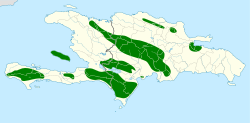Biology:Hispaniolan euphonia
| Hispaniolan euphonia | |
|---|---|
| Scientific classification | |
| Domain: | Eukaryota |
| Kingdom: | Animalia |
| Phylum: | Chordata |
| Class: | Aves |
| Order: | Passeriformes |
| Family: | Fringillidae |
| Subfamily: | Euphoniinae |
| Genus: | Chlorophonia |
| Species: | C. musica
|
| Binomial name | |
| Chlorophonia musica (Gmelin, JF, 1789)
| |

| |
| Synonyms | |
|
Euphonia musica | |
The Hispaniolan euphonia (Chlorophonia musica) is a bird species in the finch family, Fringillidae that is endemic to the island of Hispaniola in the Caribbean.
Taxonomy
The Hispaniolan euphonia was formally described in 1789 by the German naturalist Johann Friedrich Gmelin in his revised and expanded edition of Carl Linnaeus's Systema Naturae. He placed it with the manakins in the genus Pipra and coined the binomial name Pipra musica.[2] The specific epithet is from Latin musicus meaning "musical" or "musician".[3] Gmelin based his account on "L'organiste", a bird from Saint-Domingue, a French colony on the island of Hispaniola, that had been described in 1778 by the French polymath the Comte de Buffon in his multi-volume work, Histoire Naturelle des Oiseaux.[4] A hand-coloured engraving by François-Nicolas Martinet was published separately to accompany Buffon's text.[5]
The Hispaniolan euphonia was formerly placed in the genus Euphonia.[6] A molecular phylogenetic study published in 2020 found that the "blue-hooded" euphonias, the Hispaniolan, elegant and golden-rumped euphonias, formed a distinct clade that was sister to the genus Chlorophonia.[7] To resolve the paraphyly these three species were moved from Euphonia to Chlorophonia.[8][9]
The Hispaniolan euphonia was previously considered to be conspecific with the Puerto Rican euphonia (Chlorophonia sclateri) and the Lesser Antillean euphonia (Chlorophonia flavifrons). The common name "Antillean euphonia" was used for the species complex. The complex was split based on the significant differences in plumage.[8][10]
Distribution and habitat
It is found on the island of Hispaniola, (Dominican Republic and Haiti).[11] Its natural habitats are subtropical or tropical dry forest, subtropical or tropical moist lowland forest, and heavily degraded former forest.
References
- ↑ BirdLife International (2017). "Euphonia musica". IUCN Red List of Threatened Species 2017: e.T103868399A111175216. doi:10.2305/IUCN.UK.2017-1.RLTS.T103868399A111175216.en. https://www.iucnredlist.org/species/103868399/111175216. Retrieved 2 November 2022.
- ↑ Gmelin, Johann Friedrich (1789) (in Latin). Systema naturae per regna tria naturae : secundum classes, ordines, genera, species, cum characteribus, differentiis, synonymis, locis. 1, Part 2 (13th ed.). Lipsiae [Leipzig]: Georg. Emanuel. Beer. p. 1004. https://www.biodiversitylibrary.org/page/2656499.
- ↑ Jobling, James A. (2010). The Helm Dictionary of Scientific Bird Names. London: Christopher Helm. p. 262. ISBN 978-1-4081-2501-4. https://archive.org/stream/Helm_Dictionary_of_Scientific_Bird_Names_by_James_A._Jobling#page/n262/mode/1up.
- ↑ Buffon, Georges-Louis Leclerc de (1778). "L'Organiste" (in French). Histoire Naturelle des Oiseaux. 4. Paris: De l'Imprimerie Royale. pp. 290-292. https://gallica.bnf.fr/ark:/12148/bpt6k10697142/f340.item.
- ↑ Buffon, Georges-Louis Leclerc de; Martinet, François-Nicolas; Daubenton, Edme-Louis; Daubenton, Louis-Jean-Marie (1765–1783). "L'Organiste de St Dominigue". Planches Enluminées D'Histoire Naturelle. 9. Paris: De L'Imprimerie Royale. Plate 809, Fig. 1. https://www.biodiversitylibrary.org/page/35224521.
- ↑ Paynter, Raymond A. Jr, ed (1970). Check-List of Birds of the World. 13. Cambridge, Massachusetts: Museum of Comparative Zoology. p. 348. https://www.biodiversitylibrary.org/page/14483583.
- ↑ Imfeld, T.S.; Barker, F.K.; Brumfield, R.T. (2020). "Mitochondrial genomes and thousands of ultraconserved elements resolve the taxonomy and historical biogeography of the Euphonia and Chlorophonia finches (Passeriformes: Fringillidae)". The Auk (ukaa034). doi:10.1093/auk/ukaa034.
- ↑ 8.0 8.1 Gill, Frank; Donsker, David; Rasmussen, Pamela, eds (July 2023). "Finches, euphonias". IOC World Bird List Version 13.2. International Ornithologists' Union. http://www.worldbirdnames.org/bow/finches/.
- ↑ Chesser, R.T.; Billerman, S.M.; Burns, K.J.; Cicero, C.; Dunn, J.L.; Hernández-Baños, B.E.; Kratter, A.W.; Lovette, I.J. et al. (2021). "Sixty-second Supplement to the American Ornithological Society’s Check-list of North American Birds". Ornithology (ukab037). doi:10.1093/ornithology/ukab037.
- ↑ Chesser, R.T.; Billerman, S.M.; Burns, K.J.; Cicero, C.; Dunn, J.L.; Hernández-Baños, B.E.; Jiménez, R.A.; Kratter, A.W. et al. (2023). "Sixty-fourth supplement to the American Ornithological Society’s Check-list of North American Birds". Ornithology 140: 1-11. doi:10.1093/ornithology/ukad023.
- ↑ "Antillean Euphonia". Cornell University. https://neotropical.birds.cornell.edu/Species-Account/nb/species/anteup1/overview.
External links
- Stamps[Usurped!] (for Lesser Antilles islands & countries-(12 stamp issues))
- Photo gallery - VIREO
- Artwork graphic (thumb); Article, High Res Graphic - oiseaux
Wikidata ☰ Q1315499 entry
 |


